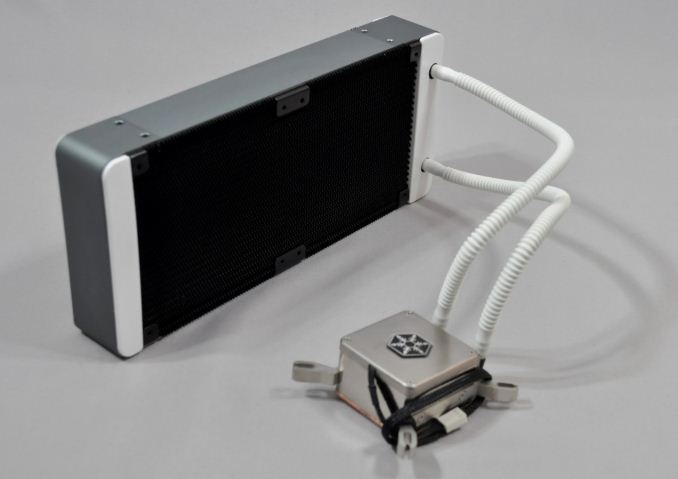Closed Loop AIO Liquid Coolers: 14-way Mega Roundup Review
by E. Fylladitakis on February 12, 2014 7:00 AM ESTSilverstone
Silverstone is another well-known name amongst advanced users and enthusiasts. The company earned their reputation from their first PSUs and original case designs and soon diversified towards cooling related products. They currently offer just two AIO liquid cooling solutions, the Tundra series. The company shipped both of them to us for this review.
Silverstone Tundra TD02
Silverstone ships the Tundra TD02 inside a large cardboard box with a black/blue theme. The box has plenty of pictures and information about the cooler printed on all of its sides. The company also supplies a fairly standard bundle with the Tundra TD02, which consists of a manual with installation instructions, mounting hardware and a syringe with thermal compound. There also is a 3-pin Y-splitter fan cable included, which can be used to power two fans off a single header. Silverstone supplies two 120mm fans with the TD02. The fans have back frames and curved, notched white blades that supposedly reduce aerodynamic noise, as well as fluid-state bearings for prolonged life. Their speed range is rather narrow, ranging from 1500 to 2500 RPM.
Visually, the Silverstone Tundra TD02 certainly stands out a lot. Although it is somewhat different, the Tundra TD02 could be coming from the same OEM that makes the Enermax Liqtech 120X as well; however, Silverstone did not want to reveal their source. The very large and deep radiator with the grey aluminum frame stands out, the size of which overwhelms any Asetek/CoolIT design. Size is not always a good thing though, as the 45mm thick design could bring serious compatibility issues, especially if the case has been designed with 27-29mm radiators in mind.
The design of the radiator is quite different from that of most other kits. Like the radiator of the Liqtech 120X, instead of wavy aluminum fins between the liquid pass-through channels, this design forms single, "seamless" fins from one side to the other, which are soldered onto the channels. The design of the fins and the overall size of the radiator though is different.
The block-pump assembly of the Tundra TD02 stands out over that of most other kits as well. It is entirely metallic, made of nickel-plated aluminum with a copper base. A badge with Silverstone's logo lies in the middle of the aluminum cap, which also has very subtle blue LEDs surrounding it. There is something unique about this block however; unlike any other assembly, including that of the Liqtech 120X, the copper base of the block is not attached to the assembly with screws, leaving the bottom of the block entirely plain. It has also been machined down to a perfect, smooth finish. The only thing that we could complain about is the use of narrow, stiff, white corrugated tubing, which is beneath the quality of such a product.
Silverstone Tundra TD03
Confusing as this may be, the Tundra TD03 actually is a smaller version of the TD02. It comes in a similarly designed cardboard box with a black/blue color theme, only it's significantly smaller. Despite the change in size however, the cooler remains very well protected within cardboard packaging and inside nylon bags. It also shares exactly the same bundle with the TD02, including the manual with the installation instructions. The two 120mm fans supplies are the same as those of the TD02, with a black frame and curved, notched white blades.
Both visually and practically, the Tundra TD03 is just a shorter version of the TD02. The radiator also shares the same design, and is just as wide and thick as the radiator of the TD02, yet nearly half as long, which means that it essentially has half the heat dissipation surface. Nevertheless, Silverstone still supplies two 120mm fans, to be used in a push-pull configuration. It is interesting to note that this radiator design appears a lot more solid, without any imperfections or bent fins, which appear to be very common on radiators with wavy aluminum fins.
As expected, the fully metallic block-pump assembly of the Tundra TD03 is identical to that of the TD02. The top and frame of the assembly are made out of nickel-plated aluminum, with the base of the block made out of solid copper. Even the mounting braces are made of solid aluminum, with those meant for Intel CPUs preinstalled on the block from the factory. Once again, the copper base is not attached to the aluminum frame with screws, at least not screws visible from the bottom of the assembly, leaving the base of the cooler perfectly clean and smooth.
























139 Comments
View All Comments
piroroadkill - Wednesday, February 12, 2014 - link
This is great, but where's at least a couple of air coolers in there for reference?I'd recommend the ever popular and classic Noctua NH-D14 since it's a widely reviewed, well known reference point.
piroroadkill - Wednesday, February 12, 2014 - link
If only I could edit my reply. I see that there is a category in Bench for CPU coolers. Never mind!ddriver - Wednesday, February 12, 2014 - link
It would still be a good idea to include a few high performance air coolers to compare how they do against the low end h2o coolers.just4U - Thursday, February 13, 2014 - link
Or even a Coolermaster 212 which is pretty much the go-to HSF for standard builds due to cost/cooling performance.MrSpadge - Wednesday, February 12, 2014 - link
Agreed - one standard high performance air cooler for ~50€ would suffice, but not including any feels incomplete.jmke - Wednesday, February 12, 2014 - link
so true, would have been a very good idea to throw in a €20 and €50 air cooler, using one of the 120mm fans to see how these water coolers compare.jmke - Wednesday, February 12, 2014 - link
best performance/noise CPU coolers is the Noctua in their charts. One of the best AIO is the NZXT Kraken X60. Let's see how they stack up:Noctua NH-U14S (2 Fans 100%) 43.1°C / 33.3 dBA / €70
NZXT Kraken X60 (Silent) 41.2°C / 30.5 dBA / €140
is a few °C difference worth an extra €70? is a HSF worth €70?
how important is CPU temperature?
if you don't overclock, keeping CPU temp below max would suffice...
mr_tawan - Wednesday, February 12, 2014 - link
Personally I use closed-loop water cooler(corsair H60) because the large air cooler I used (CM Hyper212) gets in the way of ram modules (people with intel chip does not suffer from this, AFAIK). With water cooler, I can put 4 DIMM on the mainboard without any problems.In my system, there is no significant differences between these two cooler. Water cooler is a little bit louder, btw.
Idonno - Saturday, December 6, 2014 - link
I agree 100%. Plus the sheer weight (on the MB and CPU) and size that an air cooler like the Noctua NH-U14S has to be to be even remotely competitive is absolutely ridiculous.It's not just the better temps that closed loop water coolers provide, it's convenience, accessibility, less strain on critical components and better temps.
All-in-all the higher cost of closed loop water coolers is IMO worth every penny.
E.Fyll - Wednesday, February 12, 2014 - link
Unfortunately, the few air coolers that I still have in my house are outdated. Yet, there will be many air cooler reviews and roundups coming in the near future, with their results directly comparable to those of this review. :)